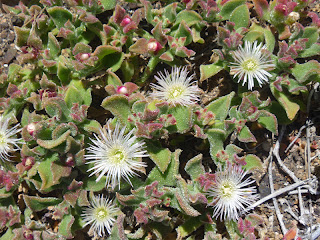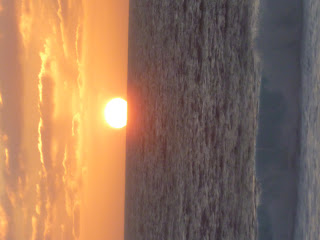We deviated a little from our plans as we had heard a lot about Quobba Point. This area provided a coast line that was a complete contrast to the areas further north where we had just been. Although there were some areas of beach, mostly it was about rugged rocky cliff faces with huge waves crashing into them. Our camp site, Quoba Station, was a sheep farm of 103,000 acres with around 15,000 sheep. The camp area was along side the homestead and shearing shed - a fairly rugged set up.
The first day there we went for a wander along the beach in front of the station. Instead of sand it was more made up of broken coral and endless clam shells. In the shallows of the water we were able to see live clams, corals and sea urchins. Along further the beach ended in a rocky outcrop from which people were fishing. Apparently, on the higher cliff faces, they do something called "balloon fishing" which involves attached your fishing line to a helium filled balloon, casting it out and having it hanging around one to two meters above the water waiting for mackerel to jump out and take the bait. Would have been great to see.
We went down to the point which is a popular fishing area and home to around 40-50 fishing shacks. The buildings are very basic - you don't need much when it's all about the fish. They were mostly deserted while we were there and we expect they are busy when the fishing is good. We went for a snorkel at the point and again saw some spectacular coral and fish, however, as the water was fairly shallow, both were smaller than we had seen further north. Nevertheless it was still a great experience. We also checked out the blow hole in this area which is out on the edge of a rocky outcrop. Some large waves hitting the rock face here and forcing their way high into the air through the blow hole. The experience of getting out close to the edge is really quite scary. Still thinking about the welcoming sign that reads "King Waves Kill" (refer below).
We also traveled north of the point along the dirt road to witness the cliff faces touching the sea. Some areas these would be up to 100 metres high. Had the most unusual experience of coming across a set of traffic lights in the middle of nowhere on a bitumen road which cut across our dirt road. Turns out the road was for the Rio Tinto salt mine and the lights were to stop the traffic on the dirt road (our road) as the Rio Tinto trucks traveled from the salt mine out to the Rio Tinto wharf where the salt was loaded directly on to the boats.





















No comments:
Post a Comment